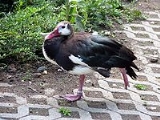
Spur-winged Goose
Encyclopedia
The Spur-winged Goose is a large bird
in the family Anatidae
, related to the geese
and the shelducks
, but distinct from both of these in a number of anatomical features, and therefore treated in its own subfamily, the Plectropterinae. It occurs in wetland
s throughout sub-Saharan Africa.
Adults are 75–115 cm (29.5–45.3 in) long and weigh on average 4–6.8 kg (8.8–15 lb), rarely up to 10 kg (22 lb), with males much larger than the females. The wingspan can range from 150 to 200 cm (59.1 to 78.7 in). They are the largest Africa
n waterfowl and are, on average, the world's largest "goose". They are mainly black, with a white face and large white wing patches. The long legs are flesh-coloured. The nominate race P. g. gambensis has extensive white on the belly and flanks, but the smaller-bodied subspecies P. g. niger, which occurs south of the Zambezi River, has only a small white belly patch.
The male differs from the female, not only in size, but also in having a larger red facial patch extending back from the red bill, and a knob at the base of the upper mandible. This is a quiet species, but may give a thin whistle in flight.
The large nest is usually concealed in vegetation near water, but tree holes, other cavities, and old Hamerkop nests may be used. The spur on the bend of the wing may be used in disputes. This abundant and gregarious species feeds by grazing, but spends the middle part of the day resting by water.
The Spur-winged Goose is one of the species to which the Agreement on the Conservation of African-Eurasian Migratory Waterbirds (AEWA
) applies.
Bird
Birds are feathered, winged, bipedal, endothermic , egg-laying, vertebrate animals. Around 10,000 living species and 188 families makes them the most speciose class of tetrapod vertebrates. They inhabit ecosystems across the globe, from the Arctic to the Antarctic. Extant birds range in size from...
in the family Anatidae
Anatidae
Anatidae is the biological family of birds that includes ducks, geese and swans. The family has a cosmopolitan distribution, occurring on all the world's continents except Antarctica and on most of the world's islands and island groups...
, related to the geese
Goose
The word goose is the English name for a group of waterfowl, belonging to the family Anatidae. This family also includes swans, most of which are larger than true geese, and ducks, which are smaller....
and the shelducks
Tadorninae
The Tadorninae is the shelduck-sheldgoose subfamily of the Anatidae, the biological family that includes the ducks and most duck-like waterfowl such as the geese and swans....
, but distinct from both of these in a number of anatomical features, and therefore treated in its own subfamily, the Plectropterinae. It occurs in wetland
Wetland
A wetland is an area of land whose soil is saturated with water either permanently or seasonally. Wetlands are categorised by their characteristic vegetation, which is adapted to these unique soil conditions....
s throughout sub-Saharan Africa.
Adults are 75–115 cm (29.5–45.3 in) long and weigh on average 4–6.8 kg (8.8–15 lb), rarely up to 10 kg (22 lb), with males much larger than the females. The wingspan can range from 150 to 200 cm (59.1 to 78.7 in). They are the largest Africa
Africa
Africa is the world's second largest and second most populous continent, after Asia. At about 30.2 million km² including adjacent islands, it covers 6% of the Earth's total surface area and 20.4% of the total land area...
n waterfowl and are, on average, the world's largest "goose". They are mainly black, with a white face and large white wing patches. The long legs are flesh-coloured. The nominate race P. g. gambensis has extensive white on the belly and flanks, but the smaller-bodied subspecies P. g. niger, which occurs south of the Zambezi River, has only a small white belly patch.
The male differs from the female, not only in size, but also in having a larger red facial patch extending back from the red bill, and a knob at the base of the upper mandible. This is a quiet species, but may give a thin whistle in flight.
The large nest is usually concealed in vegetation near water, but tree holes, other cavities, and old Hamerkop nests may be used. The spur on the bend of the wing may be used in disputes. This abundant and gregarious species feeds by grazing, but spends the middle part of the day resting by water.
The Spur-winged Goose is one of the species to which the Agreement on the Conservation of African-Eurasian Migratory Waterbirds (AEWA
AEWA
The Agreement on the Conservation of African-Eurasian Migratory Waterbirds is the largest of its kind developed so far under the Bonn Convention. It was concluded on 16 June 1995 at The Hague, the Netherlands and entered into force on 1 November 1999 after the required number of at least fourteen...
) applies.

